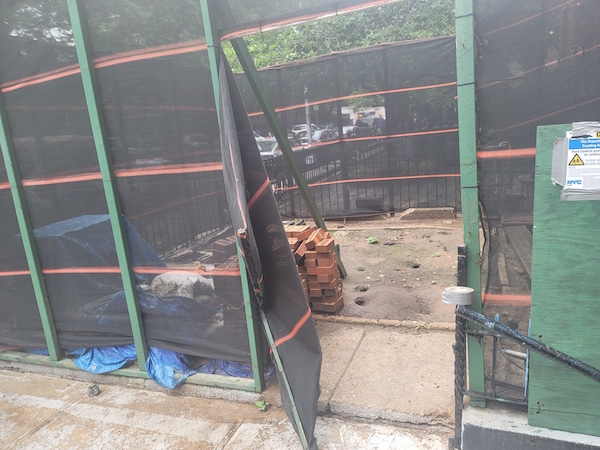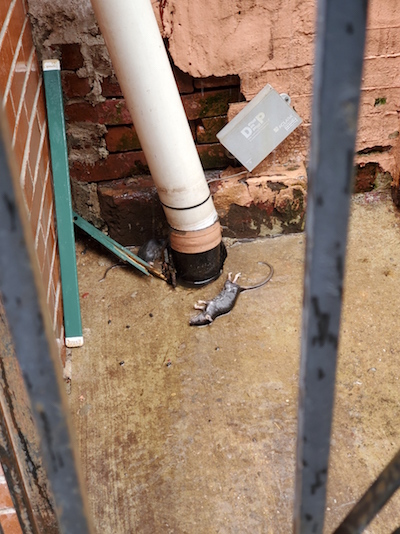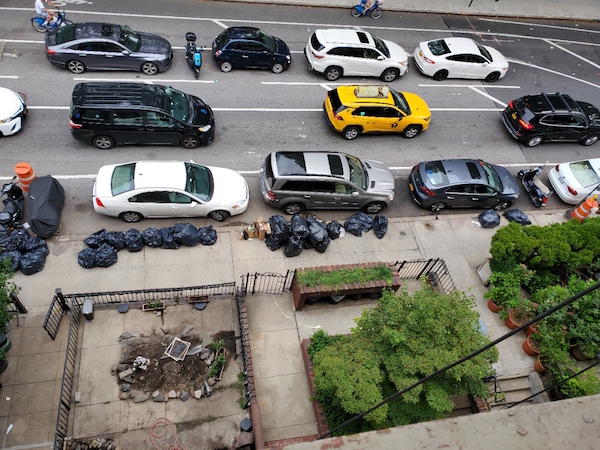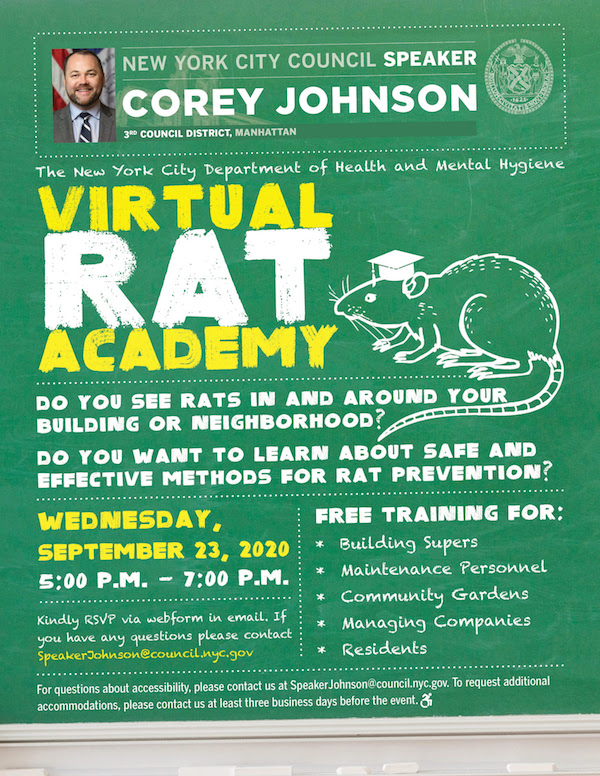NOTE: This is Part I of our report. Part II will publish tomorrow (Fri., Nov. 5, 2021)

BY BONNIE ROSENSTOCK | A group of rats is called a “mischief”—which is nowhere near as whimsical as it sounds when they’re running over your feet, or announcing their presence with evidence that remains long after they’ve retreated into a series of burrows that surround your property.
A swath of West 29th Street in Chelsea has been hit especially hard, the invasion attributed to the pandemic, but also aided and abetted by the confluence of human behavior, poor sanitation compliance, and delayed actions.
Fern Luskin lives on Lamartine Place, the historic district located on West 29th Street (btw. Eighth & Ninth Aves.). She and her neighbors have been plagued by an uptick in the rat population that, not coincidentally, began around the time residents fled the city and certain businesses ceased operation. On September 8, 2020, Luskin appealed to The New York Times to investigate their plight (they didn’t), declaring that the situation has “reached epic proportions.”
According to Bobby Corrigan, a leading urban rodentologist interviewed in The Times on May 28, 2020, there are certain colonies of rats in the city that have depended on restaurants’ nightly trash for hundreds of generations, coming out of the sewers and alleys to chomp their way through the trash bags. (Their incisors grow 14 inches a year.) With the shutdown, these wily, resourceful creatures became desperate, hungry, and fearless, adapting to daytime forays as well.
Last August 2020, at the behest of Luskin and her neighbors, city officials did a walk-through of the beleaguered block. Participants included Erik Bottcher, then chief of staff to New York City Council Speaker Corey Johnson, whose District 3 includes Chelsea. (Bottcher, the Democratic candidate for Johnson’s Council seat, won election on Nov 2.) Also on the walk-through was Frances Dottino, Case Manager/Public Health Sanitarian; and Angela Stravitz, Supervising Case Manager, Veterinary and Pest Control Services, both with the New York City Department of Health and Mental Hygiene (DOHMH).
According to Luskin, on that rat tour, violations were given to a number of building owners on the block who had rat burrows and feces on their property. Dottino said that if the building owners took preventive measures, the rat situation would be eliminated in six months, reported Luskin, “but it didn’t because some of the owners didn’t cooperate (one has since sold his building).”
However, in an email to Stravitz on September 4, 2020, Luskin reported that all the owners, from 341 through 349, and possibly 355 and 353, have either put the rat poison in their rat burrows or put down rat stations. “But the rats are winning the battle,” Luskin lamented.

Luskin goes on to say, “They have expanded the burrow you saw in 347 and dug a new one a couple of days ago even though we have the new garbage cans and rat poison in two of the three burrows; 345, 341 and 305 have new burrows that you didn’t see a few weeks ago. At night there are lots of rats running through the yards at least from 339 to 355, and we see what we think are rat feces in 347 and 345 and I think possibly in the building on the north side of 29th at Eighth Ave. I’ve seen and smelled dead, decomposing rats. The owners of 345 tried to get their exterminator to come once a week, but they are totally booked. The exterminator for 347 at first said it was illegal to put rat poison in the burrows with a funnel until I sent the owner the photo from the relevant page in the rat handbook you [Stravitz] gave me.
“The owners are trying to deal with this problem, but this is a major nightmare, and we need the city’s help.” (Rats reach sexual maturity after nine weeks and females can give birth to six litters per year, consisting of up to 12 babies. Do the math.)
NYC Department of Sanitation (DSNY) Press Secretary Vincent Gragnani confirmed, in an October 15 email to Chelsea Community News (CCNews), that sidewalk litter was also reported on Lamartine Place, “and this is the responsibility of the property owner,” he said. “All property owners are legally required to keep their sidewalk clean, as well as 18 inches into the street.”
What further exacerbated the problem was the digging of a water main on West 29th Street that went on for years. “Rats go crazy for tunnels,” said Luskin. Then, construction at the landmark Hopper-Gibbons House (339 W. 29th St.), Manhattan’s only documented Underground Railroad site, suddenly stopped because of the pandemic, allowing rats to dig interconnecting burrows via garden areas along the block. (Luskin and a small group of dedicated preservationists have spent years successfully advocating for Hopper-Gibbons House, in the courts and in the court of public opinion.)
There were “a ton of rat burrows found by Dottino,” said Luskin. “The owner, Tony Mamounas, had workmen put concrete over the garden area. It was a poor job, with openings and crevices and wooden planks abandoned over a year. I saw a live rat emerge from under the planks.” On July 2 of this year, Luskin wrote to Dottino that the NYC Office of Pest Control observed 20-25 rat burrows in front of the building, “which have just been paved over.”
In addition, the construction on the façade of 301 West 29th Street/383 Eighth Ave. (a wrap-around building with two addresses) and the scaffolding in front of the building contributed to the rat race. “They [owners Cretan Association Omonoia, Inc., 32-33 31st St. in Astoria] left the scaffolding in place for a long time and kept pausing construction,” noted Luskin. “There are open crevices. I’ve seen dead and live rats there.” (Rats can squeeze into an opening that is half an inch.) The scaffolding was removed in mid-summer, but the owners didn’t seal the crevices. ”There was one lone rat bait station, which needs to be replaced,” she said.
In an October 13 email to CCNews, Andrew Rudansky, Press Secretary for the NYC Department of Buildings (DOB), stated that while DOB regulates both scaffolds and sidewalk sheds, they don’t have jurisdiction over pest issues in the City. “311 complaints for pest issues are handled by the NYC Department of Housing Preservation and Development (HPD) and NYC Department of Health and Mental Hygiene (DOHMH).”
In a July 15, 2021 email, Dottino said to Luskin, “I performed the inspections on every property on the block (W. 28th, Eighth, W. 30th, and Ninth), as well as the adjacent block on West 29th St. There were several that already have open tickets. This means that compliance inspections will be conducted on them.”
On October 15, Michael Lanza, DOHMH Deputy Press Secretary, responded to a CCNews query for clarification of the process. “When a property fails an initial inspection,” wrote Lanza, “the Health Department sends the property owner a Commissioner’s Order to Abate (COTA). The COTA will contain the inspection report detailing the findings and guidance on how to address problem conditions, including relevant contact information. The property owner can contact the Health Department for help addressing the problem(s). A property owner has a minimum of five days to either fix the conditions or to contact the Health Department for help. Once conditions have been addressed, an inspector will then conduct a follow-up (compliance) inspection. If no signs of rats are present, the property passes the compliance inspection. If such signs or conditions are still present, the property fails the compliance inspection and the owner is issued a summons subject to fines.”
When asked if the City can put down rat poison without the owner’s consent, Lanza replied that the NYC Health Code specifies that property owners are responsible for pest management. However, “the Health Department may take action to address rat activity when the owner fails to do so. The owner will be billed if the Health Department needs to: Perform additional compliance inspections; Bait the property or conduct monitoring visits; Clean up harborage conditions.”
It has been recorded that rats will taste just a portion of bait at first, wait and see if it makes them sick, and then eat the rest. But if other food options are available, Lanza noted, they will eschew the bait, so these food sources should be removed. They can also develop resistance to many poisons over time. Lanza also advises food service establishments to frequently clean underneath outdoor dining structures and employ a pest management firm to regularly inspect, monitor and treat for rodents. “Mass extermination will always be unsuccessful if the underlying conditions that promote and sustain rats are not addressed,” he said.

One source of rat sustenance has been the trash generated by the people who frequent the Holy Apostles Soup Kitchen at 296 Ninth Ave. at W. 28th St. (located in Penn South 8A Community Room). They strew leftovers and garbage on the streets, around the nearby bus shelter, in Penn South and in Chelsea Park (W. 27th St. and Ninth Ave.), said Luskin. Matt Green, Deputy Chief of Staff/District Director for Speaker Corey Johnson, apprised Holy Apostles Chief Operating Officer Michael Ottley of the condition, and on June 29, 2021, he responded to Green in an email that after each meal they are sweeping the area to pick up all excess trash from the neighborhood left behind by their guests.
“With that being said we have an exterminator that comes on a weekly basis,” he wrote. “I understand that the rats have become a huge problem and have been for a long period of time. This is also compounded by the amount of construction in the area. We have cleaned the dense grass areas and rat-proofed our garden bed. I will continue to train and explain the importance of picking up after each meal period. Our exterminators have been made aware, and we are aggressively treating our property and have made great progress. The rat issue is coming from more than one source, and the surrounding buildings must take an aggressive approach, it’s just not a Holy Apostles issue, it’s a neighborhood problem. We are not the only source but just one symptom and one part of the solution.”
Adding more fuel to the block’s firestorm, the electric wires on the block exploded in mid-September. Con Edison began to repair the electrical system on September 22, so they had to dig up the street to replace them. At the same time, they were working on the gas lines (start date August 1; completion date, ASAP, according to the posted information), thereby exposing manholes that harbor rats. When DSNY couldn’t pick up the garbage because the street was initially blocked off, Green coordinated with Con Ed and DSNY to return to pick up the garbage immediately after Con Ed finished work for the day. According to Luskin, she doesn’t think the street has been blocked off since then. And in fact, the work on the electrical cable that exploded and the gas lines are “apparently finished,” she said. “The signs and ditches are gone.”
In the past, however, Sanitation trucks have skipped pick-up days on the block, which Luskin has meticulously documented with time-stamped photos. For example, on Friday, September 24, she said that they hadn’t picked up garbage on the sidewalk since Thursday night, and “It will continue to sit there until Monday.” Most recently, Friday and Sunday (Oct. 29 and 31), the garbage wasn’t collected either, but that could be attributed to the workers’ anti-vax protest slow-down.
Now that businesses have reopened and more New Yorkers are spending time outdoors, rat activity has exploded all over the city. So far this year, there have been approximately 20,000 rat complaints citywide brought on by a $45.6 million DSNY budget cut, which has reduced trash pick-up. Due to the pandemic, street cleaning services have also been reduced. According to Christopher Agazzi, DSNY, District Superintendent Manhattan 4, cars on West 29th Street are no longer required to move for street cleaning on Tuesdays, just Thursdays, but they still come on Tuesdays, which seems baffling.
On Wednesday, October 6, staff from Council Speaker Johnson’s office organized another walk-through, which started at the northwest corner of Eighth and Ninth Aves. at W. 29th St. and ended at Chelsea Park. Participants were Luskin and several other block residents; Agazzi (DSNY); Green; Brittany Bowen, Liaison to Community Board 4/Speaker Johnson; Stravitz and Dottino (DOHMH).
Luskin reported that the NYC Department of Parks and Recreation (Parks) hasn’t been doing a very good job picking up litter in Chelsea Park. Dottino said she issued a number of letters to them about this. Agazzi stated that since Parks owns Chelsea Park, they are responsible for removing the garbage not only from the park proper, but from the sidewalk in front of it (on the west side of Ninth Ave. at West 28th Street), which is where Luskin saw the litter, near a bus shelter.

In an October 15 email, Megan Moriarty, Press Officer, responding to CCNews, said, “We routinely maintain Chelsea Park with rat abatement treatments and regular cleaning. We also recently installed new trash bins as part of our citywide anti-litter efforts. Chelsea Park is cleaned daily; we will continue to monitor and adjust efforts as needed. Our staff work hard to keep our parks clean and safe for all New Yorkers.”
Luskin told the group that the previous night she had witnessed rats running over the barricades fronting some of the properties and running towards her from the pathway of 315. “The UPS delivery person who was still making his deliveries around 7:30pm told me they have jumped towards him at 309 and regularly run over his feet,” she added.
The group spotted a dead rat near 315 West 29th Street that Luskin’s neighbor said had been there for over a week. “There was lots of rat scat in front of the Hopper-Gibbons house,” said Luskin. “We pointed out the wooden planks in front of this building from which I saw a live rat emerge a few weeks ago, the gaps in the concrete recently poured in the front yard and the crevices in the pathway that need to be sealed. There is plenty of evidence of rat feces even in front of buildings that are diligently trying to thwart the problem (like 303 and 305).”
In a written statement to CCNews, Speaker Johnson, said, “It didn’t take us long to see troubling evidence of a serious rat problem on this block. We all must do our part if we want to be serious about preventing rats in our neighborhoods. My office will continue to work with DOHMH to secure rat-resistant garbage cans for his block, and we’ll continue to hold our Rat Academy training, which we’ve done since 2015 to educate property owners and building managers on best practices to prevent rats on their property.”
“We would always give out rat-proof garbage cans at our annual Rat Academy,” added Green in an October 12 phone interview, “but now it’s virtual [the last one held in June], and there’s an inventory shortage because of the pandemic. DOHMH told us they have prioritized this block when they get them [anticipated this fall], and we are eager to get them to the property owners. They are very big, sturdy and rat-resistant.”
DOHMH has ongoing Rat Academy trainings. Visit ww1.nyc.gov to register for their free, three-hour virtual course. They also offered a Rat Academy for Community Gardeners on October 27.
NOTE: On Friday, November 4, we published the second part of this two-part investigation, with the focus on effective methods of rat mitigation and extermination. To read Part II, click here.
Chelsea Community News is made possible with the help of our awesome advertisers, and the support of our readers. If you like what you see, please consider taking part in our GoFundMe campaign (click here). To make a direct donation, give feedback, or send a Letter to the Editor, email scott@chelseacommunitynews.com.

Pingback: Hell’s Kitchen Advocates & Allies Take ‘Action Against Litter and Rats’ – Chelsea Community News
Pingback: This Week in Chelsea: March 14-20, 2022 – Chelsea Community News
Pingback: This Week in Chelsea: February 21-27, 2022 – Chelsea Community News
Pingback: This Week in Chelsea: January 3-9, 2022 – Chelsea Community News
Pingback: Rat-Ridden Street Prompts Residents to Review the Dos and Dont’s of Rodent Removal – Chelsea Community News